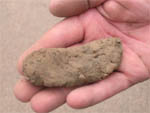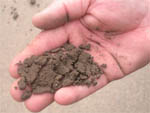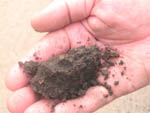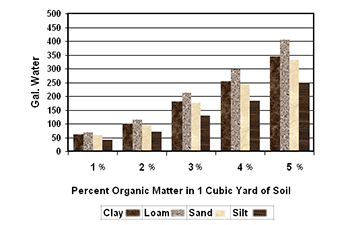Most soils can be improved by adding compost, which helps retain water in the soil and at the plant’s roots. You can add compost to flower beds and gardens, as well as to soil before laying sod or planting trees and shrubs. You also can use compost as a top dressing on existing lawns.
Compost is 100 percent organic matter. You can buy it, or you can create it from leaves, lawn clippings and vegetable-waste products, such as cucumber peels and coffee grounds. Compost can be made from a pile of leaves in a stray corner of the yard, or from a bin with air circulation and paddles to turn the pile. It also can be left alone under a black plastic cover (to protect it from Colorado's arid climate) and turned and watered frequently.
Compost can reduce outdoor watering by an estimated 25 percent. Buy compost with a stable material that will not burn your lawn or planting beds (class I and class II composts are best). See below for other tips and information.
Soil types
Most soils are a loam that consists of clay, silt, sand and some organic matter. A yard or garden is not likely to be pure clay or sand and likely contains natural organic matter from decomposing leaves and debris. The table below shows three common types of soil, each predominantly clay, sand or silt.
| Three Common Soil Types | ||
|---|---|---|
| Clay Loam | Sandy Loam | Silty Loam |
 |

|

|
| Clay soils are sticky and easy to shape. They often require sand and organic matter for full amendment. Clay is the gluey "peanut butter" of soils, but it can dry to a hard, almost impermeable surface | Pure sand is visibly granular with no adhesiveness, gritty like dry salt or sugar. Most sandy soils will break up easily, even when wet. Water poured on them simply runs through. | Silt particles are the happy medium between the grit of sand and the glue of clay. Its granules are smaller than sand, but not as small as clay. A silty loam is smooth like clay but breaks up like sand. |
How am I saving water?
One hundred pounds of average Denver soil, which is a 1- by 10-foot row tilled 6 inches deep, mixed with one pound of compost will hold an additional 33 pounds, or four gallons, of water. Add five pounds of compost to that soil, and it will hold nearly 200 pounds, or 25 gallons, of water.
Different soils benefit differently from compost. Compost improves aeration in clay soil and improves nutrient retention in sandy soil. The table below shows the relationship between the percent of compost and the amount of water that can be retained by four soil types.
How much water you use is linked to the percentage of organic matter in your soil. Sustained plant growth requires slow release of water into the soil. Healthy plants in a moist bed rich in organic material need watering less frequently.
Water Capacity

Table 1: Water retention in three soil extremes and loam
Data chart adapted with permission from "Compost Chat," by A1 Organics of Eaton, CO (970-454-3492).
What is compost?
Compost is 100 percent organic matter. You can buy it, or you can create it from leaves, lawn clippings and vegetable-waste products, such as cucumber peels and coffee grounds.
Compost can be made from a pile of leaves in a stray corner of the yard, or from a bin with air circulation and paddles to turn the pile. It also can be left alone under a black plastic cover (to protect it from Colorado's arid climate) and turned and watered frequently.
Many websites, including the city of Denver’s, provide instructions for composting.
